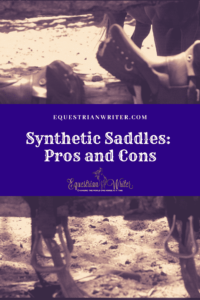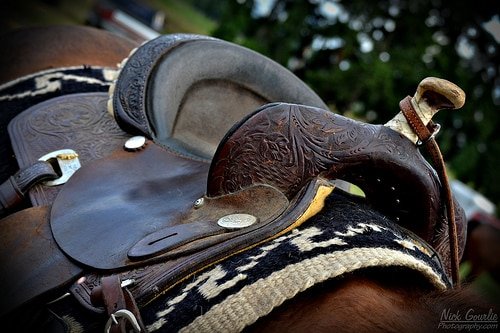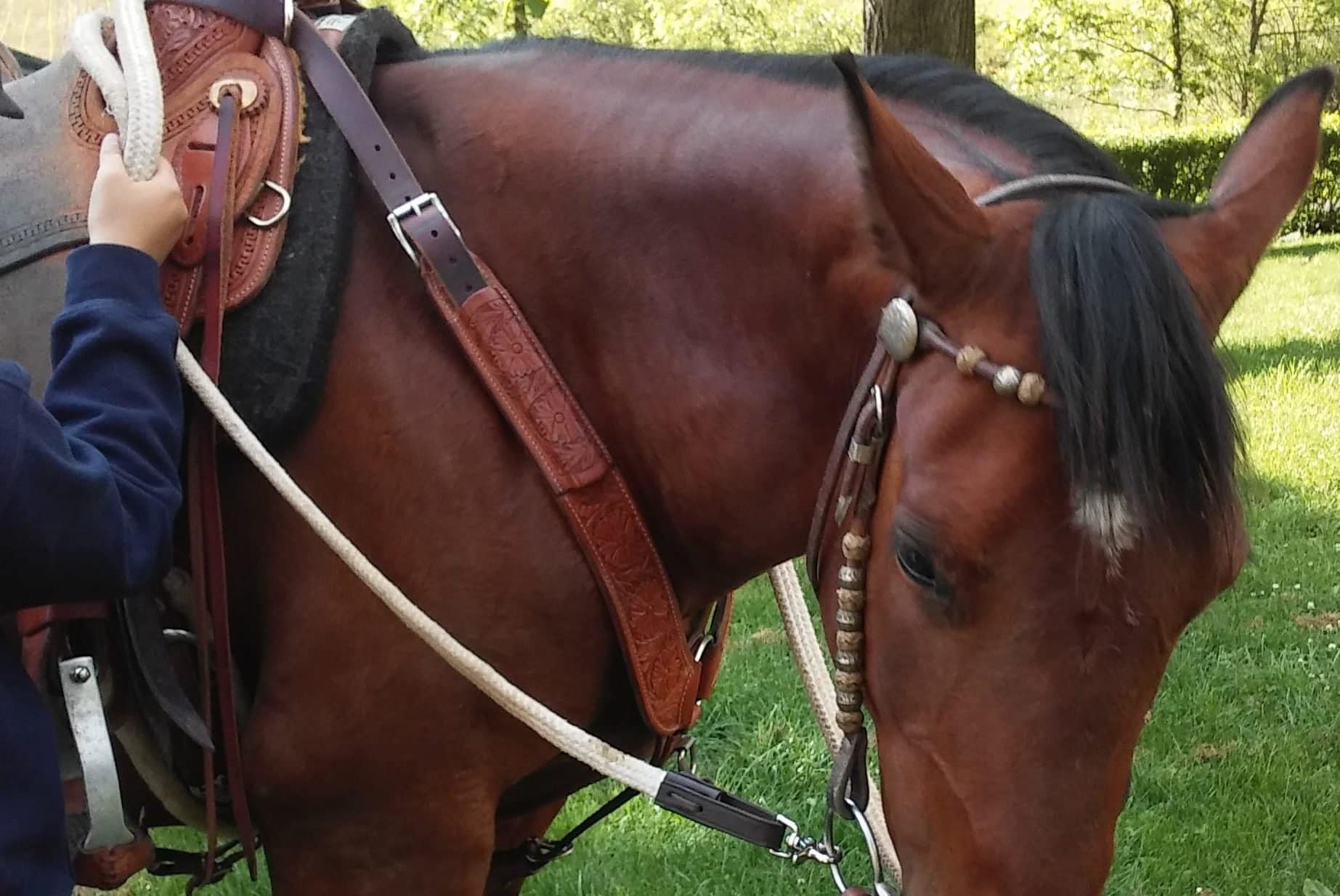

Last week we started the discussion of synthetic vs natural materials by addressing the issue of saddle pads and cinches. Today we will address the pros and cons of synthetic saddles.
Saddle Trees 101
A saddle tree consists of six essential parts:
- bars
- fork
- cantle
- horn
- gullet
- gullet channel
The bars form the base of the tree. They run parallel with the horse’s spine with one on either side. They are the part of the saddle that is actually weight-bearing. The fork hold the bars together in the front, forming the gullet, which is the cutout underneath the fork, and the pommel which supports the horn of the saddle. The gullet, of course, is the part that goes over the horse’s withers and is where we have to be careful of pinching or rubbing on the withers. The open space between the bars along the spin is the gullet channel which allows for air flow and protects the spine so that the saddle isn’t putting pressure and damaging the vertebrae. The cantle holds the bars together in the back and forms the back of the seat.
Fitting a Saddle Tree
The fit of a saddle tree is determined by the shape of the bars. The bars are the weight-bearing part of the saddle. Well fitting bars on a western saddle will apply approximately 3/4 lbs of pressure per square inch with a 150 lb rider. In order to ensure even distribution of weight, the bars must be in even contact with horse’s back and the gullet channel must be wide enough to keep pressure off the spine. How well a tree fits the back of a horse is determined by the shape of the tree. There are three possible curves to the bars:
- Twist
- Rocker
- Flare
A tree with twist is curved from front to back on each side of the tree. A rocker tree is curved on the bottom of the bars. A flared tree is curved at the front and back edges of the bars.
Leather Saddles
Wood Trees
Wood trees are still commonly used in high quality leather saddles. They are generally constructed using softer woods such as beachwood, ash, and cottonwood. These wood allow a little more flexibility in the tree so it isn’t so rigid against the horse’s back. High quality saddle tree will then be covered in rawhide or the heavier bullhide and varnished to seal the rawhide.
A wood tree cannot be made in a mold like a fiberglass tree. Wood trees must be made individually with much more attention to detail. This ensures better fit and support to your horse’s back than mass produced fiber glass trees or treeless saddles.
Of course, all the attention to detail will show up on the price tag. Leathers saddles with quality wood trees will run up to 25% more expensive than synthetic saddles. A saddle with a wood tree will also be heavier.
Stability
A better fitting tree distributes the weight more evenly and makes the saddle easier to carry despite the weight. Even bars also make a more balanced seat. Padded seats are all the rage now in many disciplines, but they change shape over time as they become packed down. This changes the balance of the seat and negatively impacts performance in high speed, high precision events. Hardseats are the way to go. A quality hardseat will be just as comfortable as a new padded seat, but it will maintain the same level of comfort for the life of the saddle. Leather fenders do require some breaking in, but using heavier metal stirrups helps give you more leverage so they break in much faster. The pain of breaking in new leather fenders is worth it in the long run as they provide more stability to your leg. A quality leather fender will not be bulky under you leg on provide you with any less feel than a synthetic one as some people are prone to assuming.
Synthetic Saddles
Fiberglass Trees
Fiberglass trees are the most common type of synthetic trees. They can be found in cheap leather saddles as well as fully synthetic saddles. Fiberglass trees are mass produced in molds. As the molds wear over time, imperfections start to appear causing variances in the quality from on tree to another. Many fiberglass trees have little bumps and ridges that attest to this process. Even the tiniest bumps unbalance the bars and dig into your horse’s back.
Stability
Some people prefer synthetic saddles because they do not require breaking in like leather saddles. However, the synthetic fenders are not going to give your leg the stability it needs, especially for events involving speed, fast turns, or quick stops. The seats are usually padded due to the nature of the construction. Many people prefer padded seats no matter what kind of saddle it is, but padded seats change over time. They become packed down and change shape, throwing off the balance and stability of your seat. Hardseats can be found in synthetic saddles, but the nature of the mass produced tree makes them uneven and uncomfortable. Those bumps and ridges from the poorly maintained manufacturing molds are magnified when you have the misfortune of sitting on them.
Photo by EliTucker










A great Roping Saddle will be functional as well as attractive. It should fit both the horse and the rider comfortably, and be strong enough to withstand the pressures of roping. While practicality is still the most important factor when choosing a roping saddle, fancy versions are becoming increasingly popular at ropings. Most saddle companies offer these fanciful options and some even offer limited editions.
While both styles are designed for long-backed horses, the reining saddle is more upright and “on pocket” in design. This saddle helps riders stay balanced during fast starts. It also has low-profile rigging, a short cantle, and a curved skirt. One of the most popular saddles used in reining is the Wintec New Generation Close Contact Saddle, which features a cutout skirt and close-contact jockeys. Roping saddles are also similar to barrel racing saddles. Although their pommel is lower than that of barrel racing saddles, they have the same deep seat as their barrel-racing counterparts. However, unlike barrel-racing saddles, roping saddles are heavier than their barrel-racing counterparts. If you’re a roping rider, a roping saddle is a better option.
Mounted shooting saddles can’t be roped out
I,m also looking for that lighter western saddle that’s lighter. I,m 67 and not ready to quit. I was looking into a small skirt Endurance without the horn it,s just round but my horse is wide and I can not see any FQHB they all say fiber.
I bought a synthteic Western saddle because of the weight (I’m not able to lift a heavy leather saddle). In any event, I feel that my synthetic saddle bobbles around. I can see it when I’m lunging my horse, and I can feel it when I’m riding in the saddle. Has anyone else experienced this with a synthetic saddle? My leather English saddle is very secure. Could the girth I’m using with the synthetic saddle be causing this or is instability the nature of synthetic saddles? Thank you.
I am looking into a synthetic saddle because of weight,my lifting it onto my 15 hand gelding.I am 64 and lol don’t have the strength I used to. I only ride for pleasure,.any recommendations? Cost is a factor.Thank you .
I have been riding horses for the majority of my life. I have both leather and synthetic saddles. Both quality brands and both have held up to what I have put them through. The low quality brands of both styles have not handled very well at all. The issue is more about what you are going to be doing in them. Riding in my name brand synthetic endurance saddle has sure helped save my horse some weight and discomfort on a twenty plus mike ride. Of course I wouldn’t use it for the playdays I go to though, that’s a job for my Billy Cook barrel saddle.
Perhaps my biased against synthetics is due to not finding the right one. I will freely admit that I haven’t ridden in very many. But I’ve always been more of a traditionalist, so I have very strong opinions. Some people really like synthetics. I can see how a synthetic could be an advantage in endurance. I imagine that my 50lb, leather, rawhide-covered-wood tree wade saddle would likely be a bad choice for endurance. But I prefer something with a solid seat that doesn’t have feather light fenders that flop all over the place. My legs tend to get lost and I fall into a chair seat. It’s probably one of my biggest weaknesses. But if you can find a good quality one that fits your horse and works for you, then more power to you. 🙂